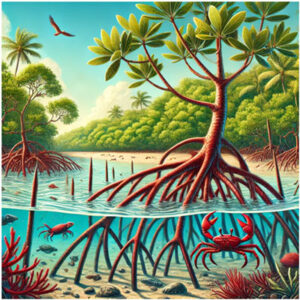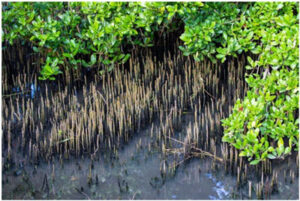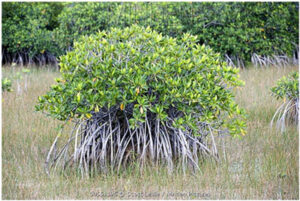Florida’s coastline is home to one of nature’s most resilient ecosystems—mangroves. These salt-tolerant trees thrive in the brackish waters of estuaries, providing shelter for marine life, stabilizing shorelines, and even serving as Florida’s first line of defense against hurricanes.
But did you know Florida has three distinct types of mangroves? Each has unique characteristics that make them easy to identify once you know what to look for. I’ve spent countless hours exploring Florida’s waterways, canoeing through tangled mangrove tunnels, and learning how to recognize each species by sight. Once you know what to look for, you’ll never see them the same way again!
In my book, Low-Tide Exploration in Florida, I highlight the role of mangroves in Florida’s delicate coastal ecosystems and the incredible wildlife that depends on them. Whether you’re wading through the shallows or simply passing by on a boardwalk, here’s how to identify Florida’s three mangrove species—and some fascinating facts you might not know!
Red Mangrove (Rhizophora mangle)
How to Identify It:
Prop roots—Long, arching roots extend from the trunk down into the water, making it look like the tree is standing on stilts.
Leaf color—Shiny, dark green on top, lighter green underneath.
Location—Found closest to the water, often growing directly in saltwater.
Unusual Fact
They “drink” saltwater! Red mangroves have a built-in filtration system in their roots that blocks salt, allowing only fresh water to enter the tree. Any salt that sneaks through is stored in older leaves, which the tree eventually sheds.
Personal Experience
While canoeing through a dense mangrove tunnel near Weedon Island Preserve, I noticed how the roots of red mangroves created an underwater maze. Small fish darted between the tangled roots, using them as shelter from larger predators. If you ever find yourself exploring these areas at low tide, look down—these roots act like a nursery, protecting young fish, crabs, and even baby sharks!
Black Mangrove (Avicennia germinans)
How to Identify It:
Pencil-like roots (pneumatophores)—Sticking up from the mud around the base of the tree, like tiny snorkels.
Leaf color—Darker green on top, silvery-gray underneath with a slightly fuzzy texture.
Location—Grows farther inland than red mangroves, in slightly higher, muddier areas.
Unusual Fact
They sweat out salt! Black mangroves excrete excess salt through special glands on their leaves. If you ever see a black mangrove leaf glistening in the sun, try licking it—you’ll taste the salt!
Personal Experience
The first time I licked a black mangrove leaf (yes, I actually did it), I was shocked by how salty it was! It’s a survival adaptation that allows these trees to thrive in salty environments. Next time you’re near a black mangrove, take a close look at the leaves—you might even see tiny salt crystals on the surface.
White Mangrove (Laguncularia racemosa)
How to Identify It:
No prop roots or pneumatophores—Grows upright like a typical tree.
Leaf shape—Oval with rounded tips, and two tiny bumps (nectaries) at the base of each leaf.
Location—Found in higher, drier areas, usually on the landward edge of a mangrove forest.
Unusual Fact
They have built-in insect repellent! Those small bumps at the base of white mangrove leaves secrete nectar that attracts ants. The ants, in turn, protect the tree by fending off leaf-eating insects.
Personal Experience
I once watched an army of ants march up a white mangrove trunk, swarming the leaves like tiny bodyguards. It turns out, this is a clever survival strategy—by feeding the ants, the tree ensures that no harmful insects stick around to damage its leaves. Nature always has a way of keeping things in balance!
Why Mangroves Matter
Mangroves are more than just trees—they’re wildlife nurseries, shoreline protectors, and climate warriors. They absorb carbon, prevent coastal erosion, and shelter everything from manatees to migratory birds. Sadly, mangroves are under threat from coastal development, pollution, and rising sea levels. Protecting these trees means protecting the delicate ecosystems they support.
If you want to learn more about Florida’s wild and watery landscapes, check out my book Low-Tide Exploration in Florida. It’s filled with more discoveries, surprising encounters, and a deep dive into the world hidden beneath the tides.



